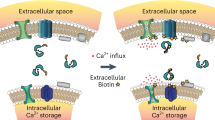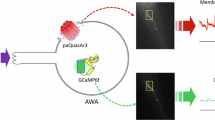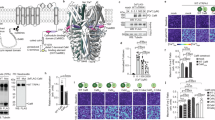Abstract
THE discovery that Ca2+ is necessary for the release of neurotransmitter, the primary means by which nerve cells communicate, led to the calcium hypothesis of neutransmitter release1–4, in which release is initiated after an action potential only by an increase in intracellular Ca2+ concentration near the release sites and is terminated (1–2 ms) by the rapid removal of Ca2+. Since then, the calcium-voltage hypothesis has been proposed5,6, in which the depolarization of the presynaptic terminals has two functions. First, in common with the calcium hypothesis, the Ca2+ conductance is increased, thereby permitting Ca2+ entry. Second, a confor-mational change is induced in a membrane molecule that renders it sensitive to Ca2+, and then binding of Ca2+ to this active form triggers release of neurotransmitter. When the membrane is repolarized, the molecule is inactivated and release is terminated, regardless of the local Ca2+ concentration at that moment. This hypothesis, in contrast to the calcium hypothesis, accounts for the insensitivity of the time course of release to experimental manipulations of intracellular Ca2+ concentation7–11, Furthermore, it explains rapid termination of release after depolarization, even though Ca2+ concentration may still be high. Here we describe experiments that distinguish between these two hypotheses and find that our results support the calcium voltage hypothesis.
This is a preview of subscription content, access via your institution
Access options
Subscribe to this journal
Receive 51 print issues and online access
$199.00 per year
only $3.90 per issue
Buy this article
- Purchase on SpringerLink
- Instant access to full article PDF
Prices may be subject to local taxes which are calculated during checkout
Similar content being viewed by others
References
Katz, B. & Miledi, R. Proc. Roy. Soc. B161, 496–503 (1965).
Miledi, R. Proc. Roy. Soc. B183, 421–425 (1973).
Katz, B. & Miledi, R. Proc. Roy. Soc. B161, 483–495 (1965).
Smith, S. U. & Augustine, G. J. Trends Neurosci. 11, 458–464 (1988).
Parnas, I., Parnas, H. & Dudel, J. Pflügers Arch. Eur. J. Physiol. 406, 131–137 (1986).
Parnas, H., Parnas, I. & Segel, L. A. Int. Rev. Neurobiol. (in the press).
Barrett, E. F. & Stevens, C. F. J. Physiol, Lond. 227, 691–708 (1972).
Matzner, H., Parnas, H. & Parnas, I. J. Physiol, Lond. 398, 109–121 (1988).
Parnas, H., Hovav, G. & Parnas, I. Biophys. J. 55, 859–874 (1989).
Datyner, N. B. & Gage, P. W. J. Physiol, Lond. 303, 299–314 (1980).
Andreu, R. & Barett, E. F. J. Physiol., Lond. 308, 79–97 (1980).
Adams, S. R., Kao, J. P. Y., Grynkiewicz, G., Minta, A. & Tsien, R. Y. J. Am. chem. Soc. 110, 3212–3220 (1988).
Zucker, R. S. & Haydon, P. G. Nature 335, 360–362 (1988).
Parnas, H., Dudel, J. & Parnas, I. Pflügers Arch. Eur. J. Physiol. 496, 121–130 (1986).
Wojtowicz, J. M. & Atwood, H. L. J. Neurobiol. 14, 385–390 (1983).
Hatt, H., Franke, C. H. & Dudel, J. Pflügers Arch. Eur. J. Physiol. 411, 17–26 (1988).
Zucker, R. S. & Lando, L. Science 231, 574–579 (1986).
Adams, O. J., Takeda, K. & Umbach, J. A. J. Physiol., Lond. 369, 145–159 (1985).
Author information
Authors and Affiliations
Rights and permissions
About this article
Cite this article
Hochner, B., Parnas, H. & Parnas, I. Membrane depolarization evokes neurotransmitter release in the absence of calcium entry. Nature 342, 433–435 (1989). https://doi.org/10.1038/342433a0
Received:
Accepted:
Published:
Issue date:
DOI: https://doi.org/10.1038/342433a0
This article is cited by
-
What are the mechanisms for analogue and digital signalling in the brain?
Nature Reviews Neuroscience (2013)
-
Control of neurotransmitter release: From Ca2+ to voltage dependent G-protein coupled receptors
Pflügers Archiv - European Journal of Physiology (2010)
-
A simulation study on the Ca2+-independent but voltage-dependent exocytosis and endocytosis in dorsal root ganglion neurons
European Biophysics Journal (2005)
-
Release of Neurotransmitter Induced by Ca2+-Uncaging: Reexamination of the Ca-Voltage Hypothesis for Release
Journal of Computational Neuroscience (2005)
-
Relation of exocytotic release of ?-aminobutyric acid to Ca2+ entry through Ca2+ channels or by reversal of the Na+/Ca2+ exchanger in synaptosomes
Pfl�gers Archiv European Journal of Physiology (1993)



